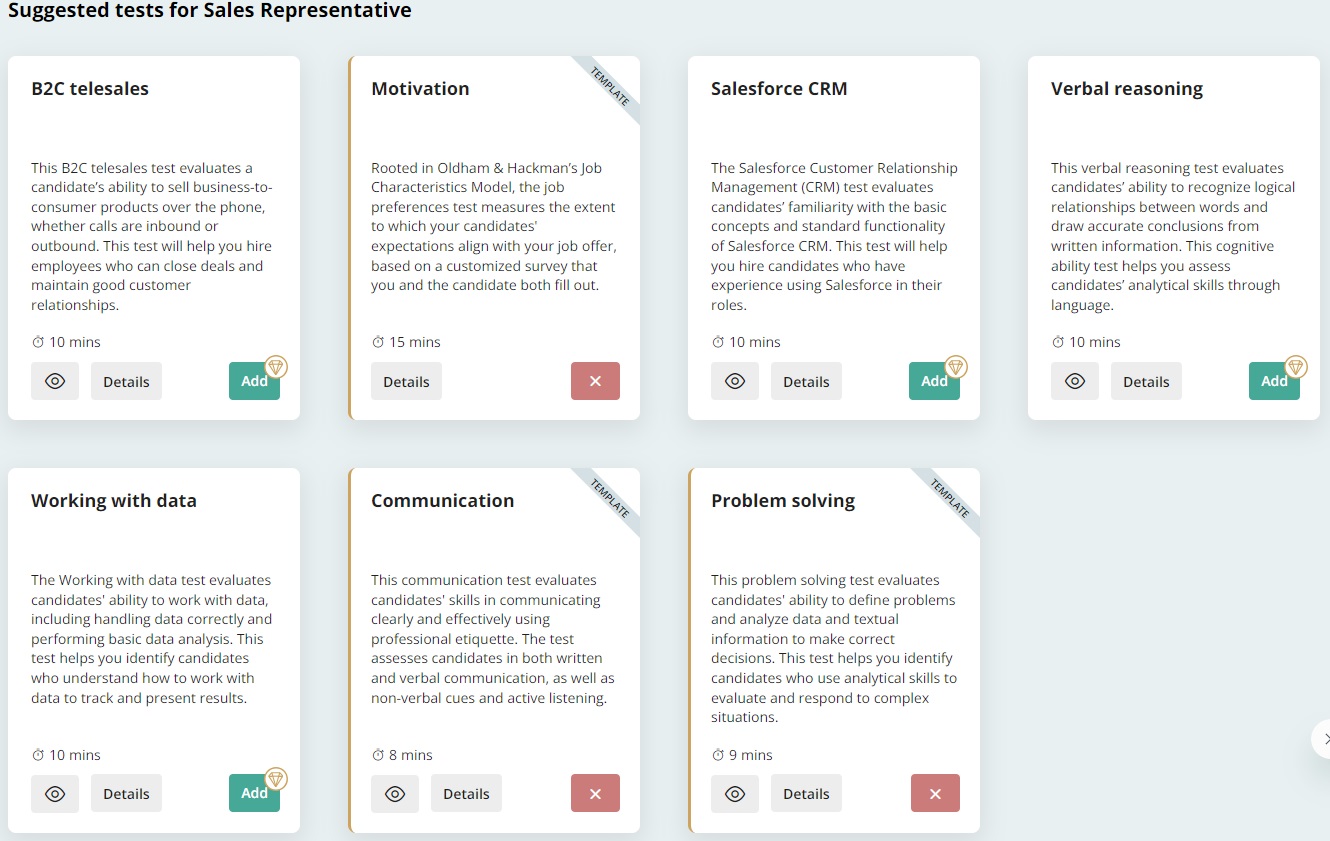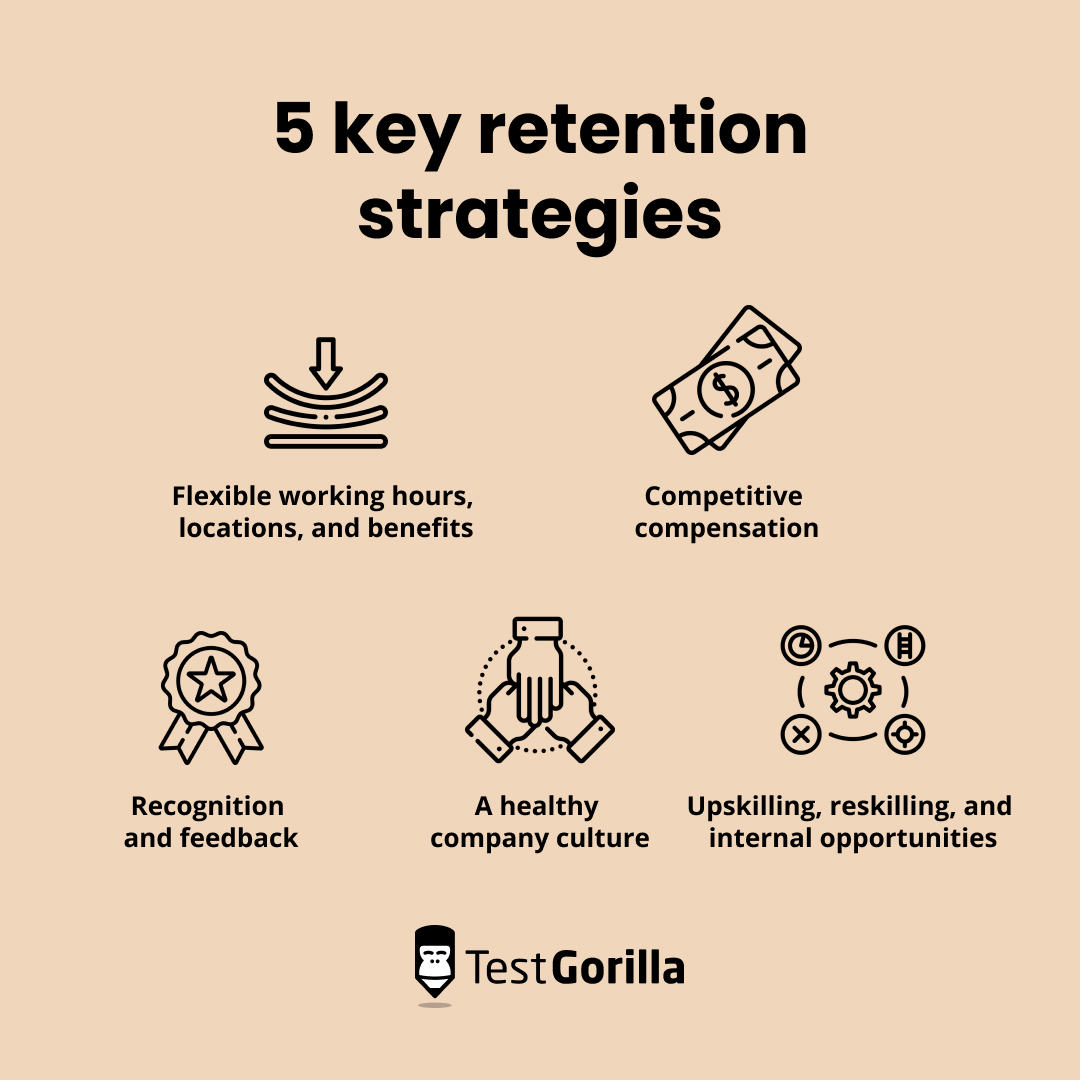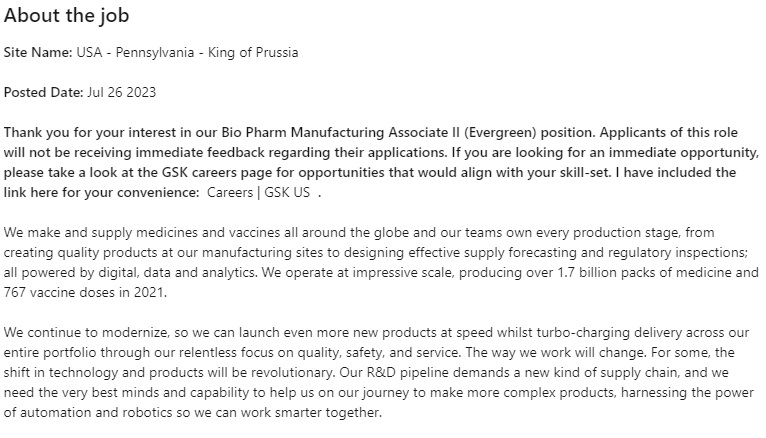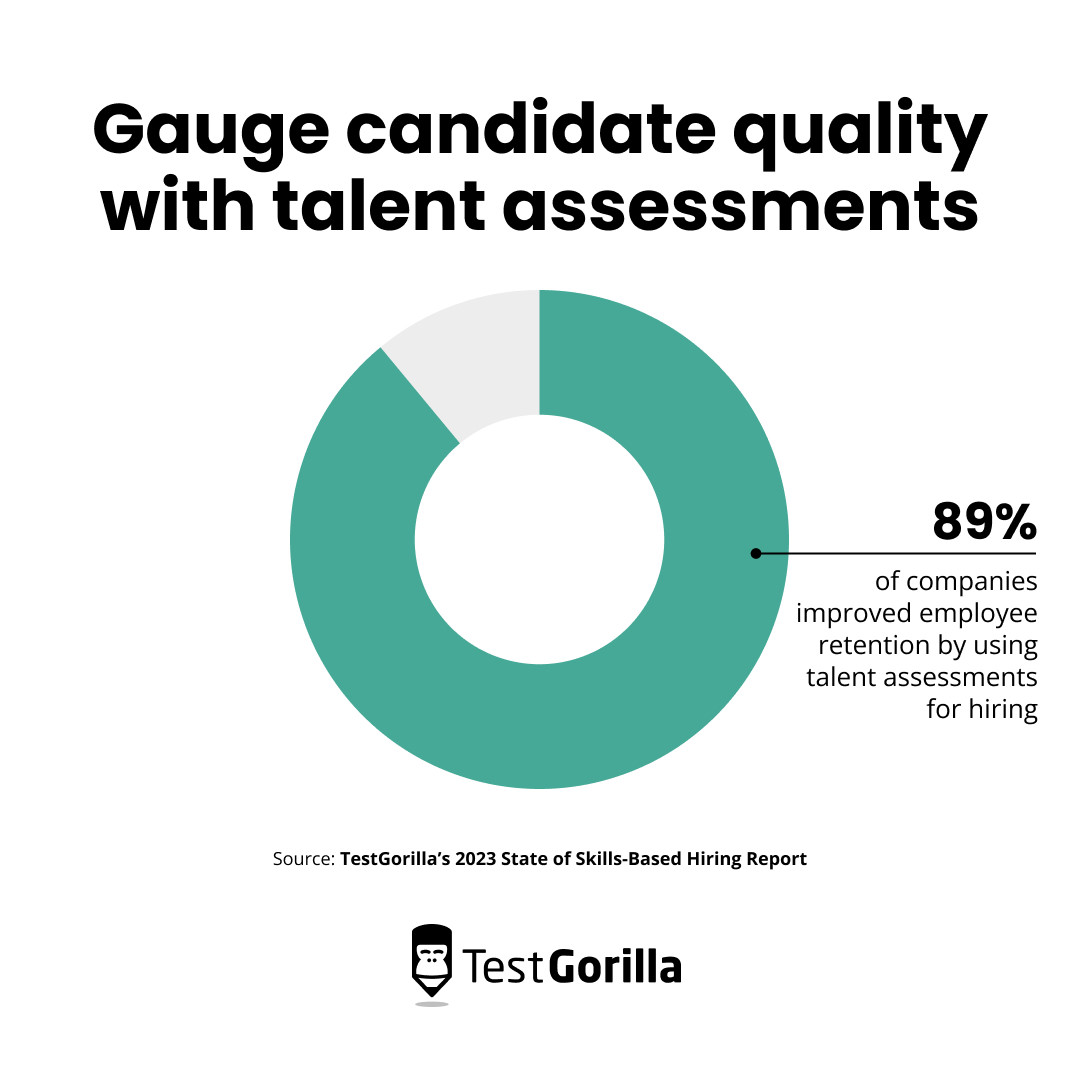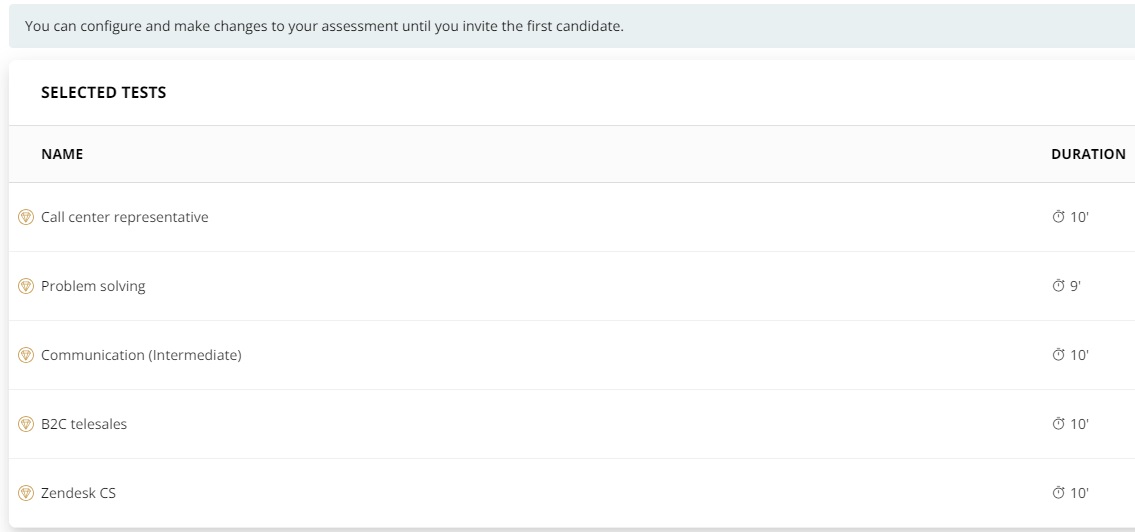You’re in an industry with high voluntary turnover, and your hiring manager hates reposting the same positions every couple of months. It’s time-consuming and counterproductive.
Industries affected by high quit rates and turnover, like leisure and hospitality, grappled to fill nearly 2 million job openings in 2023 – that’s a lot of time spent posting job listings. [1]
An evergreen job posting combats this by acting as a single long-term job listing for positions requiring frequent hiring. Such a posting keeps your talent pipeline full, enabling you to proactively fill positions rather than reactively scrambling to find a replacement.
Moreover, if you add skill tests to the mix, you don’t have to worry about recruitment gaps down the road.
Evergreen job postings may not be the best fit for every company. But if you’re in a high-turnover industry, they’re an excellent way to continuously attract candidates and fill your jobs when needed.
In this guide, we help you decide if evergreen job postings are right for you and offer you eight best practices to make the most of them.
Table of contents
What is an evergreen job posting?
An evergreen job posting is one that remains constantly open because the position experiences high turnover or is shared by many employees. These postings primarily apply to industries like healthcare, retail, call centers, banking, or hospitality.
So, what does “evergreen” mean in a job posting?
For candidates, it means you can apply at any time because the postings are often renewed and always open. For employers and human resources professionals, it means you can continuously collect applications and fill jobs as they become available, enabling you to stay on top of your staffing needs.
Whenever an organization has dozens of employees with the same job description, it can use these postings – for example, a healthcare facility hiring nurses.
You can use evergreen job postings if your employees work in different settings but perform the same job. Evergreen job posting examples include call center agents delivering customer service from multiple locations to clients worldwide.
Traditional job posting vs. evergreen job posting
Let’s take a peek at how evergreen job postings differ from traditional job postings.
Traditional job posting | Evergreen job posting |
Closes when the position is filled | Remains open or active all the time |
Is used for one hiring round | Is used for multiple hiring rounds |
Is not suited to high-volume hiring because a requisition is needed for each posting | Is ideal for high volume hiring because the requisition doesn’t close |
The position can take long to fill, which leaves openings unfilled for long periods of time | Enables continuous hiring, which fills positions as they become available |
The risks of evergreen hiring
Evergreen hiring is a great recruitment practice when you’re faced with large talent pools, but it doesn’t come without risks.
The three main challenges of evergreen hiring are:
Postings are harder to find on job boards
Hiring data is less reliable
Applicants are turned off when they don’t get a response
Evergreen jobs are hard to find on job boards
Research shows that 41% of hires find their new role through online job boards. These boards usually show the new listings at the top of the page, which means your evergreen postings move to the bottom.
The longer you keep an evergreen posting open, the lower it falls down the listings, and fewer people see it.
However, longer-term evergreen job posts actually do better than shorter-term ones in terms of visibility on search engine results pages. Search engines send more traffic to a posting that’s one year old than one that’s been up for just a couple of months. [2]
So, if you want candidates to find you on Google’s first page when they search for a job, leave your posting open, and don’t fret about falling to the bottom of job board listings.
Evergreen hiring can make hiring data less reliable
Hiring data contains metrics like time-to-fill or understanding which job descriptions get the most clicks. Using these indicators to inform your data driven recruiting has many benefits, including reducing time to hire and improving hire quality.
However, metrics can become useless when a job posting stays open for a year or longer.
Because the postings stay open, you can’t follow the metrics from the beginning to the end of each round of hiring. You can’t see how many applicants you had in each hiring round or whether you hired anyone in a particular round.
Time-to-fill is particularly important because it tells you which part of your hiring process takes too long and needs improvements.
Research advises to keep your evergreen postings open no longer than 90 days to avoid losing this important metric.[3]
Evergreen postings turn off applicants when they don’t get a response
Finally, evergreen postings can harm your employer brand when used incorrectly.
If job seekers put valuable time into finding and applying for a role, but don’t hear back for months, they may feel ignored.
Applicants don’t necessarily understand why you have open positions when you’re not actively hiring, so they feel ghosted.
Receiving no response is a major pet peeve among candidates, with one study showing that 85% of applicants dislike not hearing back from an employer they applied with.
Having no follow-up can damage your reputation if applicants spread the word about your “shady” hiring practices online.
You can use talent engagement platforms and AI chatbots to facilitate easier responses to your candidates and avoid damaging your reputation.[4]
The benefits of evergreen hiring
Despite the drawbacks, evergreen postings also have important benefits for hiring teams.
They make hiring faster, give your hiring team a surplus of talented candidates to pick from, and also save you resources and money because they entail fewer steps than using multiple listings.
Let’s take a look at the main benefits of evergreen hiring:
Keeps your talent pipeline constantly filled
Fills vacancies quickly using your large pool of applicants
Saves time and money
Keeps your talent pipeline constantly filled
If you just finished a traditional hiring round, you would normally close your posting until you need to do another one.
If they want to reapply, the candidates you didn’t hire in this round usually need to start their application again without any record of their previous attempt.
When your posting is closed, you can’t replenish your talent pipeline until you start hiring again.
This is especially difficult for sectors like retail, where the quit rate in the US outpaces other industries by more than 70%.
Evergreen postings help these industries manage their talent pool by storing applications in their talent pipeline for your next round of hiring.
You also don’t have to rely on coincidence hiring, which happens in the rare event when the top talent is available just when you have an opening for them.
You can hire before you have to, giving you a surplus of talent for onboarding.
The employees you hired are ready to jump in when you need them because they’re already familiar with their job requirements.
Fills vacancies quickly using your large pool of applicants
The industries that most benefit from using evergreen postings are those that experience regular workforce challenges, such as talent shortages. For example, 47% of healthcare recruiters are struggling to find candidates.
If you cannot find replacements quickly, it becomes difficult for your existing employees to cover for missing teammates.
Evergreen job postings ensure a constant influx of replacements so your existing team doesn’t get burnt out on picking up the slack. Relieving employees’ stress is one way to improve their productivity and wellbeing in the workplace.
Your hiring managers also benefit because you make more hires with an evergreen requisition. They spend less time on hiring and have a surplus of qualified candidates, removing a lot of stress from their plate.
This benefit extends beyond just your workforce, though. Keeping your evergreen positions filled enables your team to provide adequate service to your customers.
For some industries, filling vacancies quickly is non-negotiable. In health care, for example, delays can seriously affect the patients’ outcomes when they postpone procedures or treatments.
Saves time and money
When you make only one hire, you must close the requisition as soon as you hire your top candidate.
If you still need more people, you must spend money on opening a new requisition, posting a new opening, and going through the interview process again.
However, with evergreen hiring, you hire all the qualified candidates you need without closing the job ad, saving you time and money.
In addition, your selected candidates don’t have to retake an interview when you reopen your job ad, which can increase their engagement and interest in your company.
Candidates appreciate a straightforward hiring process and are more likely to recommend your company to others.
8 best practices for creating and managing evergreen job postings
Now that we’ve seen that overcoming the risks associated with evergreen hiring is possible and the advantages are difficult to ignore, let’s take a look at eight best practices your hiring team can take advantage of an evergreen hiring strategy.
How to manage evergreen job postings: Summary of the best practices
Best practice | How it helps |
1. Create accurate and attractive job descriptions | Attracts job candidates to your posting and fills vacancies fast |
2, Streamline the hiring process | Fills roles quickly and efficiently and keeps your talent pipeline constantly filled |
3. Optimize your talent pipeline | Minimizes the chance that candidates become disenfranchised by not hearing back about their application |
4. Adopt key retention strategies | Helps save time and money by not having to constantly keep hiring for the same role |
5. Repost your evergreen job postings on social media | Alleviates the issue of your job postings falling to the bottom of job boards |
6. Optimize your posting with SEO practices | Gives your evergreen posting high visibility and staying power on search engines |
7. Use recruitment technology | Saves time and resources in high-volume hiring and enables you to use hiring data to understand hiring bottlenecks |
8. Gauge candidate quality with talent assessments | Fills vacancies quickly and inexpensively |
1. Create accurate and attractive job descriptions
As the first point of contact with your applicants, a good evergreen job description forms the backbone of any successful evergreen hiring strategy.
Ensure it is accurate, attractive, and applicable long term to encourage potential job seekers who may find it months after you posted it to throw their hat in the ring.
Applicants need to be able to understand the role, including their daily duties and what you expect from them.
Use talent assessments on your existing workforce to identify the skills that each role entails, including soft skills, and make sure to clearly list these necessary skills in your job description.
For example, a call center representative job description would include skills like:
Strong verbal communication skills to offer support by phone
Strong written communication skills to provide chat assistance
Problem-solving skills
Time management skills
Patience and resistance to frustration
Also, use inclusive language in your job descriptions to communicate your culture and values.
Your applicants feel welcome and valued and are encouraged to apply when your language doesn’t discriminate and you don’t use gender-biased words.
2. Streamline the hiring process
Evergreen postings aim to quickly and efficiently fill roles, keeping your talent pipeline constantly filled. However, you can’t expect your job posting to do that alone.
You can make the process more efficient by streamlining the rest of the hiring process to improve your candidate experience and make your company not only well-staffed but also more agile.
Use talent assessments to quickly qualify high-quality candidates by administering the most common tests for each job posting.
For example, here are the recommended talent assessments for a sales representative:
You can also use recruitment automation to communicate with candidates and schedule interviews, reducing the number of repetitive tasks your hiring managers must do.
In addition, automation can speed up:
Candidate sourcing
Applicant screening
Candidate relationship management
A streamlined hiring process greatly benefits from an optimized talent pipeline, which leads us to the next point.
3. Optimize your talent pipeline
If you have a talent pipeline, you can start building relationships with your applicants from the beginning of the hiring process.
Building relationships resolves the issue of candidates becoming disenfranchised due to a lack of communication.
Sometimes, you only have room for one hire when you’re on a hiring round.
Keeping the unsuccessful candidates in your pipeline and contacting them when you need more hires prevents wasting efforts on starting the hiring process from scratch with a new candidate.
With talent assessments, you can identify exactly which skills the candidates have and which skills they’re missing. You can prioritize hiring them based on these skills.
Your talent pipeline is a waste if it doesn’t enable hiring managers to easily find the candidates they want.
Use an up-to-date talent pool database to avoid losing sight of the best talent during the next round of hiring.
You can also send automated email sequences to the candidates in your talent pipeline to gently nurture them and use their data to update the records in your database.
4. Adopt key retention strategies
Companies typically use evergreen job postings for high-turnover positions.
As such, one good way to assist your evergreen hiring is to reduce the need to hire so often by improving your employee retention rate.
You can do this by improving employee engagement and recognition and offering workers professional development paths to make high-turnover roles more attractive.
The best way to increase retention in evergreen roles is by using an onboarding program that gives new hires all the training they need and a mentor to guide them and make them feel part of the team.
Other key retention strategies include:
Flexible working hours, locations, and benefits
Competitive compensation
Recognition and feedback
A healthy, inclusive, and diverse company culture
Upskilling, reskilling, and opportunities for internal mobility
With these retention strategies, you position yourself to keep great talent, motivate your employees, and reduce employee turnover, saving you time and money in the long term.
5. Repost your evergreen job postings on social media
Although your job posting is evergreen, it can’t stay relevant if you don’t remind potential candidates of its existence by sharing it on social media.
With 57% of job seekers using social media to search for new positions, actively tapping into this channel provides one of your largest sources of applicants.[5]
Reposting your job posting on social media alleviates the issue of candidates not finding your open position on job boards.
It is similar to getting new applicants through referrals from existing employees.
Make sure your posting has a hook by including pictures of your workplace or a recruitment video that makes it attractive for employees to share on social media.
When they share the posting on the most popular channels, like X and LinkedIn, your pictures or videos show up in relevant news feeds, attracting the interest of thousands of candidates who are active on these platforms.
You can also make a “We are hiring” post on Facebook or LinkedIn.
Regardless of whether you use a template, include all the relevant information:
The job title
Benefits
Compensation
A call to action
In addition to reposting your postings on social media, you can also post an FAQ document with common questions and answers about the job position, the application process, and whether you’re actively hiring or not.
This helps reduce the number of repetitive inquiries while also attracting attention to your evergreen job postings.
6. Optimize your posting with SEO practices
Evergreen jobs greatly benefit from search engine optimization (SEO) when you use
simple language and SEO keywords so humans and search engines can easily understand your postings.
Simple language refers to using industry-standard or recognizable job titles and clear language that is easy to understand. Do not use jargon or gimmicky job titles, like “Dr. Fix” for a help-desk operator or “wiz kid” for a call center support person.
Optimized evergreen postings help minimize issues related to the visibility of your posts on search engines.
Optimize the job web page on your career site for Schema.org to use the shared vocabulary of all search engines. Write a meta title and meta description, and ensure your posting works on mobile devices.
Add links to the posting from your blog and career pages. The posting ranks higher on Google with each relevant link it receives.
Don’t forget about optimizing your posting’s URL. For example, if you’re hiring a web designer, your job title should say “Web Designer,” and your URL should include the words “web designer” and “job,” so it’s as narrow and accurate as possible.
7. Use recruitment technology
Recruitment technology helps you save time and resources when you need to do high-volume hiring.
The best way to go about it is to use an applicant tracking system (ATS) that can handle large numbers of applicants easily.
An ATS lets you track your candidates throughout the hiring process. It can also close openings at regular intervals and reopen them by copying them without any manual input from your hiring managers.
Recruitment technology is an excellent way to constantly update your candidate pool with top talent.
Combining it with talent assessments, like automatically scheduled structured interviews, which use the same script for each candidate, ensures that you only hire the most qualified candidates for each role.
Because your postings are closed and reopened periodically, you can also collect and use hiring data and metrics you would otherwise lose with evergreen postings.
Collecting and using hiring data can help you further fine-tune your evergreen hiring process by improving areas that take too long for your hiring managers and candidates.
8. Gauge candidate quality with talent assessments
In evergreen hiring, talent assessments ensure that you find the best culture add hires because they assess hard skills, soft skills, and personality traits.
Unlike culture fit, which often means that candidates share their colleagues’ hobbies and social interests, culture add improves your company with the unique skill set and values the new hire brings to the table.
Talent assessments give you a clearer and more rounded picture of the candidate than resumes because they evaluate skills instead of listing qualifications and making claims that may not be easy to verify.
With talent assessments, you fill vacancies quickly and save time and money because they’re reliable, quick, and inexpensive.
Moreover, you increase retention, which is a great perk in high-turnover industries. According to TestGorilla’s 2024 State of Skills-Based Hiring Report, 94% of companies improved employee retention by using talent assessments for hiring. 89% said so in 2023.
Choose tests that apply to the specific position you are trying to fill and set benchmarks to see how the candidate compares with your specific needs for the job.
Here’s an example of the different tests you can use for call center positions:
Ensure that candidates understand why you are using test assessments and what to expect from them during the early stages of recruitment.
Use an evergreen job posting for high-volume hiring
Evergreen job postings are the way to tackle high-volume hiring in industries with high turnover rates, like health care, hospitality, call centers, and banking.
When used in conjunction with a streamlined hiring process, key retention strategies, recruitment technology, and talent assessments, evergreen job postings feed your talent pipeline consistently, save time and money, and fill your job openings fast.
You can also leverage search engine preferences to increase visibility for your evergreen job postings and use automation to nurture candidates and collect hiring data.
If you want to learn more about how technology can help your evergreen hiring efforts, check out our blog about talent acquisition technology.
To ensure your evergreen postings attract candidates who can add to your culture and align well with it, consider using our Culture Add test.
Sources
Bhattarai, Abha; Penman, Maggie. (February 3, 2023). “Restaurants can’t find workers because they’ve found better jobs”. The Washington Post. Retrieved October 20, 2023. https://www.washingtonpost.com/business/2023/02/03/worker-shortage-restaurants-hotels-economy/
Kelly, Rob. (October 4, 2015). “5 Easy Tips to Recruiting for ‘Evergreen’ Jobs”. LinkedIn. Retrieved October 5, 2023. https://www.linkedin.com/pulse/5-easy-tips-recruiting-evergreen-jobs-rob-kelly
“How to Manage Evergreen Jobs & Limit Liability”. Circa Mitratech. Retrieved October 12, 2023. https://circaworks.com/articles/how-to-properly-manage-evergreen-jobs-to-limit-liability/
Ughade, Nupura. (July 27, 2023). “Strategies for Boosting Candidate Pipeline Optimization”. Sense. Retrieved October 12, 2023. https://www.sensehq.com/blog/candidate-pipeline-optimization
Koster, Adam. (April 14, 2016). “How Are Job Seekers Using Social Media?”. iCIMS. Retrieved October 12, 2023. https://www.icims.com/blog/how-are-job-seekers-using-social-media/
Related posts
Hire the best candidates with TestGorilla
Create pre-employment assessments in minutes to screen candidates, save time, and hire the best talent.
Latest posts
The best advice in pre-employment testing, in your inbox.
No spam. Unsubscribe at any time.

Hire the best. No bias. No stress.
Our screening tests identify the best candidates and make your hiring decisions faster, easier, and bias-free.
Free resources
This checklist covers key features you should look for when choosing a skills testing platform
This resource will help you develop an onboarding checklist for new hires.
How to assess your candidates' attention to detail.
Learn how to get human resources certified through HRCI or SHRM.
Learn how you can improve the level of talent at your company.
Learn how CapitalT reduced hiring bias with online skills assessments.
Learn how to make the resume process more efficient and more effective.
Improve your hiring strategy with these 7 critical recruitment metrics.
Learn how Sukhi decreased time spent reviewing resumes by 83%!
Hire more efficiently with these hacks that 99% of recruiters aren't using.
Make a business case for diversity and inclusion initiatives with this data.



